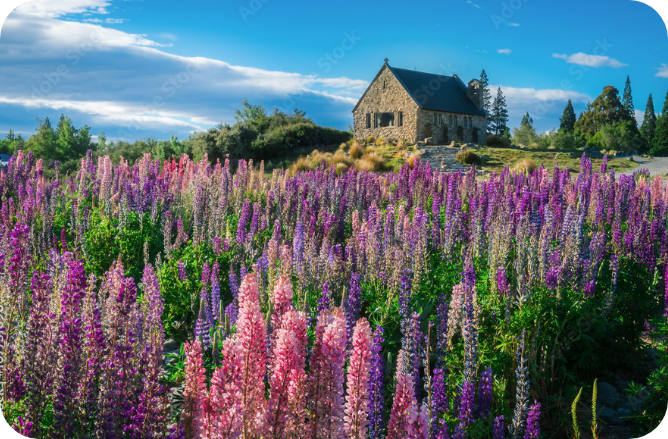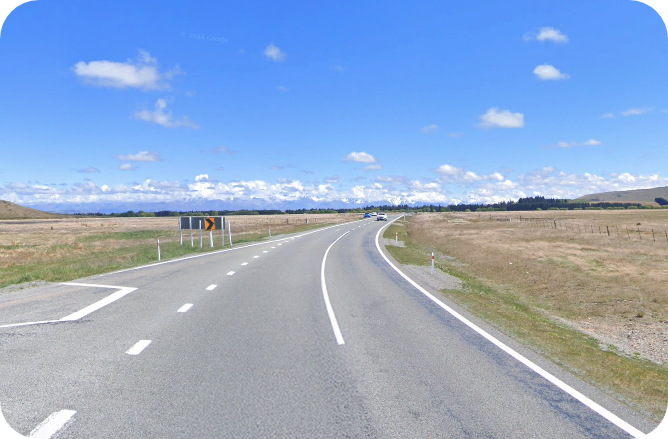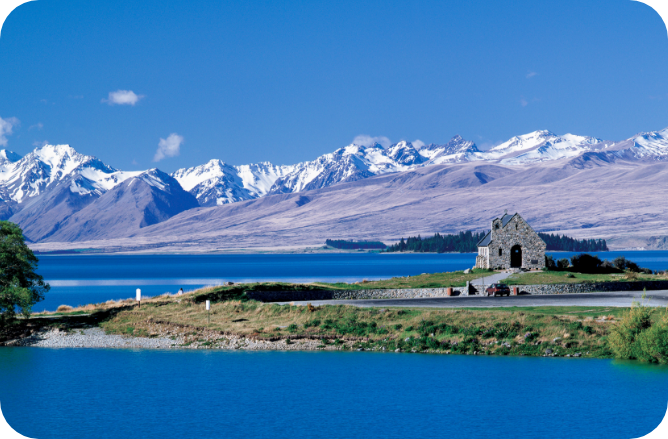

The Central South Trail ends in glorious Tekapo.
Lake Tekapo, the highest of the Mackenzie Country lakes at 712 metres above sea level, was first harnessed for hydroelectric power in a project completed in 1951. The outflow is now diverted into a canal which flows to the Tekapo B power station on Lake Pūkaki.
At the outlet of Lake Tekapo lies a small lakeside community, home to a hotel and a growing number of holiday homes. Between 1991 and 2013, the population grew from fewer than 200 to over 350, reflecting the community’s rising popularity as both a holiday destination and a place to live.
- This stop has toilet facilities
- There is a rest area in Tekapo

Dog Kennel Corner
As you pass the vibrant purple lupins in bloom in summer, you’ll arrive at Dog Kennel Corner. Here, you’ll find the mahi toi (artwork), created with cultural concepts and guidance given by Moeraki, Waihao and Arowhenua rūnanga (councils).
There is a strong desire by mana whenua to share the ancient and modern narratives associated with the Mackenzie Country. The artwork was created by Ngāi Tahu artist and designer Ross Hemera, who was invited to participate in the project due to his whakapapa connections and prior work in the area.
The mahi toi tells the story of Te Kopi o te Ōpihi (Burkes Pass) being a stopping place and gateway to Te Manahuna (Mackenzie Basin),Takapō (Lake Tekapo) and Aoraki (Mt Cook). The artwork also serves as a place to acknowledge tīpuna (ancestors) and the area’s ancient trails and rich history of mahika kai (traditional food gathering). The mahi toi takes the form of a wall panel accompanied by an information plaque, featuring explanatory text in both Te Reo Māori and English. It includes contemporary interpretations of Māori rock art, depicting figures such as the pouākai, tiki, and whakarare.

Lake Tekapo
Today, Lake Tekapo is an important centre for recreational tourism. The Church of the Good Shepherd, set in a picturesque spot overlooking the lake, is one of New Zealand’s most iconic buildings.
Lake Tekapo’s intense, milky, turquoise hue is due to a fine rock flour, ground by glacial movement and suspended in the waters. Fed by several glaciers, the inviting waters of Lake Tekapo are generally too cold for swimming, except in the shallows or on the hottest summer days. The stunning views make it an exceptional spot for running, cycling, and walking around the lake.

